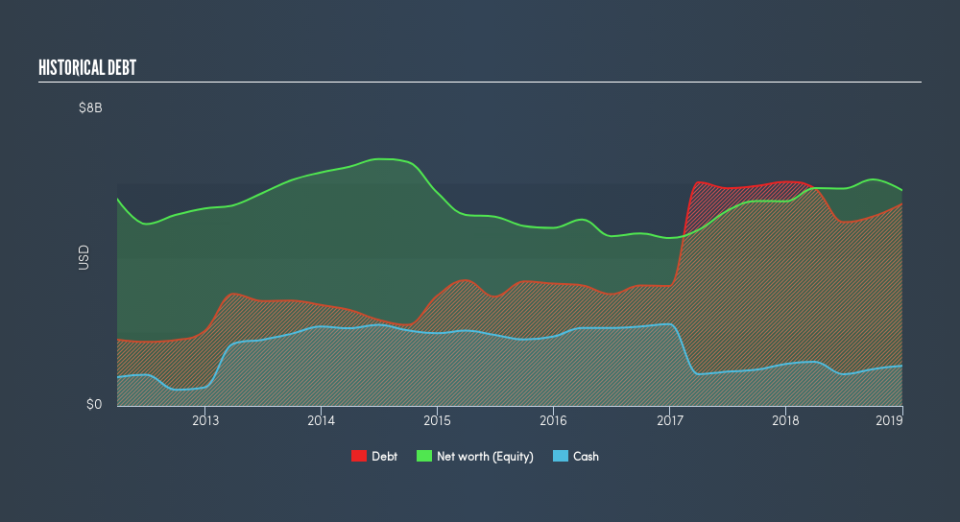Are Parker-Hannifin Corporation’s (NYSE:PH) Interest Costs Too High?

The size of Parker-Hannifin Corporation (NYSE:PH), a US$22b large-cap, often attracts investors seeking a reliable investment in the stock market. Doing business globally, large caps tend to have diversified revenue streams and attractive capital returns, making them desirable investments for risk-averse portfolios. But, its financial health remains the key to continued success. Today we will look at Parker-Hannifin’s financial liquidity and debt levels, which are strong indicators for whether the company can weather economic downturns or fund strategic acquisitions for future growth. Remember this is a very top-level look that focuses exclusively on financial health, so I recommend a deeper analysis into PH here.
Check out our latest analysis for Parker-Hannifin
Does PH Produce Much Cash Relative To Its Debt?
PH has shrunk its total debt levels in the last twelve months, from US$6.0b to US$5.4b – this includes long-term debt. With this reduction in debt, PH’s cash and short-term investments stands at US$1.1b to keep the business going. Additionally, PH has produced US$1.7b in operating cash flow over the same time period, resulting in an operating cash to total debt ratio of 31%, meaning that PH’s debt is appropriately covered by operating cash.
Does PH’s liquid assets cover its short-term commitments?
Looking at PH’s US$3.5b in current liabilities, the company has been able to meet these obligations given the level of current assets of US$5.3b, with a current ratio of 1.52x. The current ratio is the number you get when you divide current assets by current liabilities. For Machinery companies, this ratio is within a sensible range since there is a bit of a cash buffer without leaving too much capital in a low-return environment.
Can PH service its debt comfortably?
PH is a relatively highly levered company with a debt-to-equity of 94%. This is not unusual for large-caps since debt tends to be less expensive than equity because interest payments are tax deductible. Accordingly, large companies often have lower cost of capital due to easily obtained financing, providing an advantage over smaller companies. We can check to see whether PH is able to meet its debt obligations by looking at the net interest coverage ratio. Net interest should be covered by earnings before interest and tax (EBIT) by at least three times to be safe. For PH, the ratio of 10.37x suggests that interest is amply covered. High interest coverage is seen as a responsible and safe practice, which highlights why most investors believe large-caps such as PH is a safe investment.
Next Steps:
PH’s high cash coverage means that, although its debt levels are high, the company is able to utilise its borrowings efficiently in order to generate cash flow. This may mean this is an optimal capital structure for the business, given that it is also meeting its short-term commitment. I admit this is a fairly basic analysis for PH’s financial health. Other important fundamentals need to be considered alongside. You should continue to research Parker-Hannifin to get a better picture of the large-cap by looking at:
Future Outlook: What are well-informed industry analysts predicting for PH’s future growth? Take a look at our free research report of analyst consensus for PH’s outlook.
Valuation: What is PH worth today? Is the stock undervalued, even when its growth outlook is factored into its intrinsic value? The intrinsic value infographic in our free research report helps visualize whether PH is currently mispriced by the market.
Other High-Performing Stocks: Are there other stocks that provide better prospects with proven track records? Explore our free list of these great stocks here.
We aim to bring you long-term focused research analysis driven by fundamental data. Note that our analysis may not factor in the latest price-sensitive company announcements or qualitative material.
If you spot an error that warrants correction, please contact the editor at editorial-team@simplywallst.com. This article by Simply Wall St is general in nature. It does not constitute a recommendation to buy or sell any stock, and does not take account of your objectives, or your financial situation. Simply Wall St has no position in the stocks mentioned. Thank you for reading.

